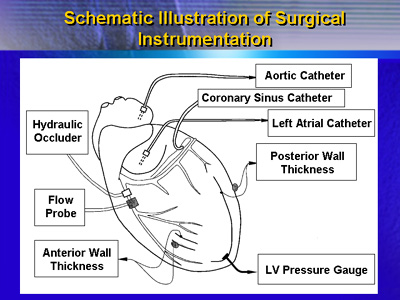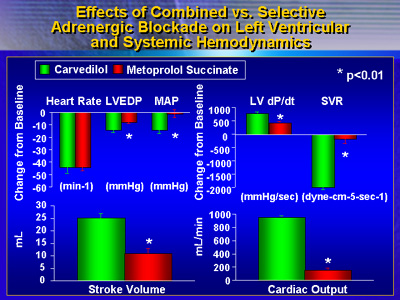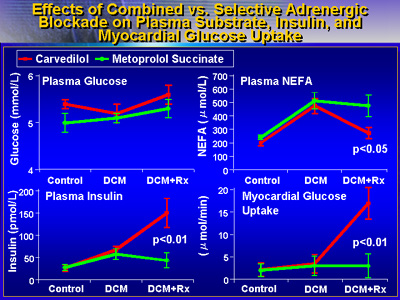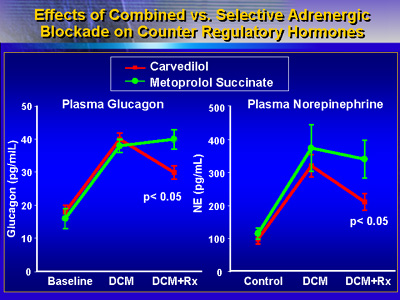| Carvedilol
has a beneficial effect on myocardial metabolism in heart failure
that does not occur with the beta-1 selective blocking agent
metoprolol succinate. This benefit occurs despite comparable
heart rate effects with the two drugs in these animal subjects.
Therefore, this beneficial effect is probably related to the
beta-2 and alpha-1 blocking properties of carvedilol.
Beta-blockers have a significant beneficial
effect on survival in patients with heart failure. However,
recent investigations show not all beta-blockers have the
same effect in these patients.
Recently, the COMET trial compared the beta-1 selective agent
metoprolol succinate against carvedilol, the combined adrenergic
blocking agent. Carvedilol has not only beta-1 blocking properties,
but also beta-2 and alpha-1 blocking properties. Results of
the COMET trial suggest carvedilol is superior to metoprolol
succinate with respect to mortality.
Dr. Shannon and colleagues wanted to determine why these
two agents might have differential effects in heart failure
patients. These researchers have focused on metabolic abnormalities
that occur in heart failure. In particular, they have found
that in failing heart preferentially uses glucose as its myocardial
metabolic substrate. Therefore, they were interested in whether
different beta-blockers have differential effects on myocardial
glucose uptake.
To compare the effects of these two beta-blockers, researchers
used rapid pacing for 29 days to induce severe dilated cardiomyopathy
in 13 chronically instrumented adult dogs.

Researchers then randomized the dogs to receive carvedilol
(Coreg) 25 mg bid or metoprolol succinate (Toprol XL) 100
mg qd for 3 days. They chose these doses in order to match
heart rate effects for the two drugs.
Researchers took hemodynamic and metabolic measurements before
treatment and on the final day of treatment. They measured
myocardial glucose uptake as the product of coronary blood
flow and transmyocardial substrate balance.
Hemodynamic effects
Researchers found that complete adrenergic blockade with
carvedilol had a significantly greater effect on hemodynamics.
Carvedilol lowered cardiac filling pressures, and improved
cardiac output to a greater extent than metoprolol. This occurred
despite the fact the matched heart rate effects for carvedilol
versus metoprolol.

Metabolic effects
Following treatment with carvedilol, plasma insulin levels
rose nearly three-fold. As a result, there was a marked improvement
in myocardial glucose uptake. By contrast, metoprolol succinate
had no effect on basal insulin levels, nor did it have an
effect on glucose uptake.

Effects on Glucoregulatory Hormones
In an attempt to understand the mechanism of improvement
in myocardial glucose uptake, investigators measured the effect
of these two beta-blockers on plasma levels of norepinephrine,
a counter-regulatory hormone to the action of insulin. Researchers
found that carvedilol suppressed plasma norepinephrine levels
to a greater extent than metoprolol succinate.
Researchers also looked at effects of glucagon, a specific
hormone that antagonizes the action of insulin. They demonstrated
that carvedilol suppressed plasma glucagon levels, whereas
metoprolol succinate did not.

Taken together, researchers believe that one the beneficial
effects of combined adrenergic blockade with carvedilol is
the improvement in metabolic utilization of glucose in the
failing heart. The mechanism appears to involve suppression
of norepinephrine and glucagon, which are key counter-regulatory
hormones to the action of insulin. These mechanistic data
may provide insight into why carvedilol was superior to metoprolol
succinate in the COMET study.
|